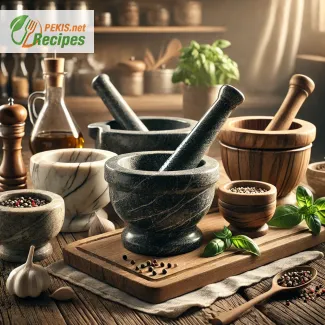
Comprehensive Guide: Selecting the Best Mortar and Pestle Set for Your Kitchen
Best Materials for Mortar and Pestle Sets
When selecting a mortar and pestle, consider materials for durability and functionality. Granite is ideal for crushing tough ingredients, while marble offers a smooth surface perfect for soft pastes. Wooden sets are best for delicate herbs, and ceramic works well for light grinding tasks.
How to Properly Season a New Mortar and Pestle
Seasoning is crucial to remove stone debris and enhance flavor absorption:
- Rinse with warm water (avoid soap).
- Grind uncooked rice until it turns grayish, indicating residual debris removal.
- Crush garlic, salt, and pepper to condition the surface.
Granite vs. Marble Mortar and Pestle: Which is Better?
- Granite: Highly durable, excellent for hard spices.
- Marble: Aesthetic and smooth but can be prone to stains.
- Verdict: For frequent use, choose granite; for lighter tasks, marble is ideal.
Top 10 Mortar and Pestle Sets for Home Kitchens
- ChefSavor Granite Set – Best for versatility.
- Vasconia Molcajete – Perfect for guacamole.
- Thai Stone Mortar – Ideal for curry pastes.
How to Clean and Maintain Your Mortar and Pestle
- Cleaning: Use warm water and a stiff brush.
- Avoid soap: It can seep into porous materials.
- Dry thoroughly: Prevent mold growth.
Using a Mortar and Pestle to Grind Spices: A Step-by-Step Guide
- Add spices to the mortar.
- Use a circular motion with the pestle.
- Continue until reaching the desired consistency.
Traditional Recipes You Can Make with a Mortar and Pestle
- Pesto: Basil, pine nuts, garlic, Parmesan, olive oil.
- Guacamole: Avocados, onions, lime, cilantro.
- Spice blends: Freshly crushed cumin, coriander, and black pepper.
Mortar and Pestle vs. Electric Grinders: Pros and Cons
- Pros: Retains natural flavors, no overheating.
- Cons: Requires effort and more time.
The History and Cultural Significance of the Mortar and Pestle
Used since ancient times for medicine, cooking, and rituals, this tool symbolizes craftsmanship and culinary heritage.
Choosing the Right Size Mortar and Pestle for Your Needs
- Small (4-6 inches): For spices.
- Medium (6-8 inches): For sauces and dips.
- Large (8+ inches): For family-sized batches.
Can You Use a Mortar and Pestle to Make Pesto?
Yes! The traditional method releases essential oils from basil, enhancing flavor.
Best Mortar and Pestle Sets for Making Guacamole
- Vasconia Granite Molcajete: Traditional and authentic.
- ChefSavor Deep Bowl: Easy mixing and serving.
How to Remove Odors from a Mortar and Pestle
- Crush lemon and coarse salt to neutralize smells.
- Rinse thoroughly with warm water.
Is a Mortar and Pestle Necessary for Authentic Cooking?
Yes. It enhances flavors, providing textures that no blender can replicate.
Alternative Uses for a Mortar and Pestle in the Kitchen
- Crush nuts for desserts.
- Make homemade curry pastes.
- Grind coffee beans for a fresh brew.
Safety Tips for Using a Mortar and Pestle
- Place on a stable surface to prevent slipping.
- Use proper technique to avoid wrist strain.
How to Choose Between a Molcajete and a Traditional Mortar and Pestle
- Molcajete: Best for Mexican cuisine, made from volcanic rock.
- Traditional Mortar: Versatile for all cuisines.
The Role of Mortar and Pestle in Ayurvedic Medicine
Used for centuries to crush herbs, aiding in the creation of medicinal pastes and powders.
Can You Use a Mortar and Pestle to Grind Coffee Beans?
Yes. Although labor-intensive, it results in a bold, rich flavor.
Top Mistakes to Avoid When Using a Mortar and Pestle
- Using soap: It can absorb into porous materials.
- Not seasoning before use: Can lead to gritty textures.
- Applying too much pressure: Risk of cracking.
This detailed guide delivers essential knowledge about mortar and pestle sets, blending practical advice with culinary inspiration to help you make the most of this timeless kitchen tool.